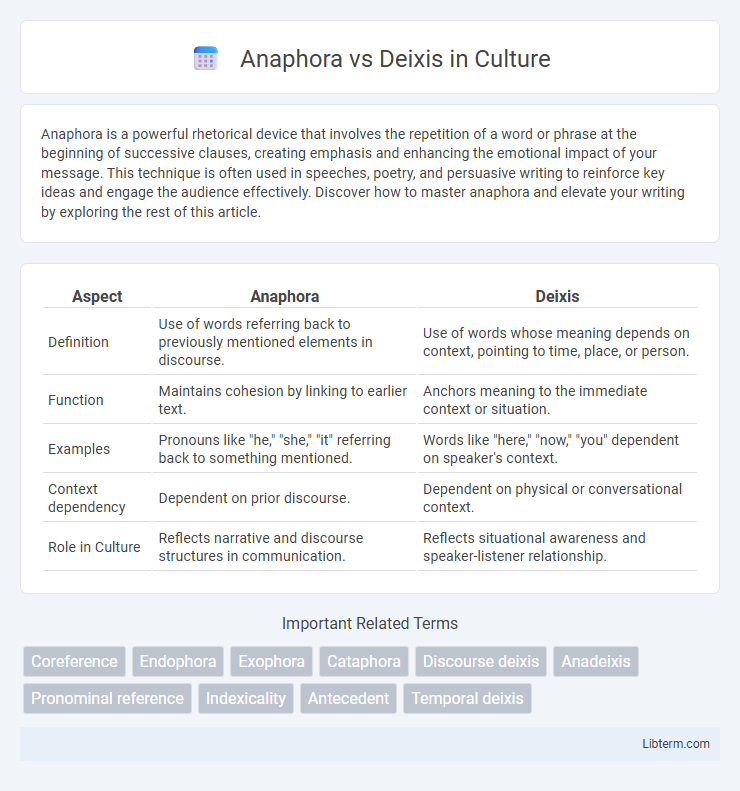Anaphora is a powerful rhetorical device that involves the repetition of a word or phrase at the beginning of successive clauses, creating emphasis and enhancing the emotional impact of your message. This technique is often used in speeches, poetry, and persuasive writing to reinforce key ideas and engage the audience effectively. Discover how to master anaphora and elevate your writing by exploring the rest of this article.
Table of Comparison
| Aspect | Anaphora | Deixis |
|---|---|---|
| Definition | Use of words referring back to previously mentioned elements in discourse. | Use of words whose meaning depends on context, pointing to time, place, or person. |
| Function | Maintains cohesion by linking to earlier text. | Anchors meaning to the immediate context or situation. |
| Examples | Pronouns like "he," "she," "it" referring back to something mentioned. | Words like "here," "now," "you" dependent on speaker's context. |
| Context dependency | Dependent on prior discourse. | Dependent on physical or conversational context. |
| Role in Culture | Reflects narrative and discourse structures in communication. | Reflects situational awareness and speaker-listener relationship. |
Introduction to Anaphora and Deixis
Anaphora refers to the use of expressions that depend on another expression previously mentioned in the discourse for their interpretation, such as pronouns like "he," "she," or "it" referring back to a noun. Deixis involves words or phrases, like "this," "that," "here," or "now," whose meaning is context-dependent and requires situational information to be understood. Both anaphora and deixis are crucial for maintaining coherence and facilitating reference in language, with anaphora linking elements within the text and deixis anchoring expressions to the context of utterance.
Defining Anaphora: Meaning and Function
Anaphora is a linguistic mechanism where a word or phrase, often a pronoun, refers back to an earlier word or phrase within the same discourse, establishing coherence and avoiding redundancy. Its primary function is to maintain textual cohesion by linking an element to a previously mentioned antecedent, facilitating understanding in communication. This contrasts with deixis, which relies on the context of the utterance for meaning, as anaphora depends on textual relationships within the discourse.
Defining Deixis: Meaning and Function
Deixis refers to words and phrases, such as pronouns and demonstratives, that require contextual information to convey meaning, pointing directly to elements within the speech situation. It functions by anchoring linguistic expressions to aspects of the speaker's context, including time, place, and participants, enabling listeners to interpret references like "this," "that," "here," and "now." Understanding deixis is crucial for analyzing how language users encode and decode meaning relative to their communicative environment.
Core Differences Between Anaphora and Deixis
Anaphora involves referring back to an element previously mentioned in the discourse, typically using pronouns or other substitutive expressions, ensuring coherence by connecting sentences. Deixis, in contrast, relies on contextual information such as the speaker's location, time, or social setting to interpret expressions like "this," "that," "here," or "now," which lack meaning outside the situational context. The core difference lies in anaphora's dependence on linguistic antecedents within the text, whereas deixis requires extralinguistic context for accurate understanding.
Types of Anaphora in Language
Anaphora in language refers to the use of expressions that depend on another element for their interpretation, including types such as pronominal anaphora, where pronouns replace nouns, and lexical anaphora, which involves repeated or synonymous nouns. Deixis differs by requiring contextual information to resolve references, typically involving demonstratives, temporal, and person deixis. Understanding these distinctions is crucial for analyzing sentence cohesion and meaning in discourse analysis.
Types of Deictic Expressions
Deictic expressions include several types such as person deixis, which refers to participants in the conversation like "I," "you," and "they," place deixis indicating spatial locations such as "here" and "there," and time deixis referring to temporal points like "now" and "then." Other types involve discourse deixis, which points to parts of the text or conversation, and social deixis that indicates social relationships using forms of address or honorifics. Understanding these categories clarifies how deixis grounds meaning in context, distinguishing it from anaphora's reference within linguistic content.
Linguistic Roles: Reference vs. Context
Anaphora and deixis serve distinct linguistic roles in reference and context. Anaphora involves using expressions that refer back to something previously mentioned in the discourse, establishing cohesion through internal textual reference. Deixis, by contrast, relies on contextual information outside the text, such as speaker location or time, to interpret words like "here," "now," or "you," anchoring meaning to the immediate communicative environment.
Examples of Anaphora in Sentences
Anaphora in sentences refers to the use of a word or phrase that refers back to another word or phrase previously mentioned, typically a pronoun referring to a noun antecedent. For example, in the sentence "Susan went to the market because she wanted fresh vegetables," the pronoun "she" is an anaphoric reference to "Susan." Another example is "The dog barked loudly, and it scared the children," where "it" refers back anaphorically to "the dog.
Examples of Deixis in Communication
Deixis in communication involves words like "here," "there," "you," and "now," which require contextual information to convey meaning effectively. For example, the sentence "She is over there" depends on the speaker's location to clarify "there." Similarly, "I will do it tomorrow" relies on the time of utterance to specify "tomorrow," demonstrating the essential role of deixis in interpreting communicative intent.
Importance in Discourse and Text Analysis
Anaphora and deixis are crucial in discourse and text analysis for understanding reference and coherence; anaphora involves referring back to previously mentioned elements, enhancing textual cohesion, while deixis relies on context-dependent expressions that anchor meaning to the speaker's temporal or spatial frame. Recognizing anaphoric relations improves tracking of entities across sentences, vital for tasks like coreference resolution and information extraction. Deictic expressions require contextual interpretation, essential for accurate semantic parsing and pragmatic analysis in natural language processing.
Anaphora Infographic

 libterm.com
libterm.com